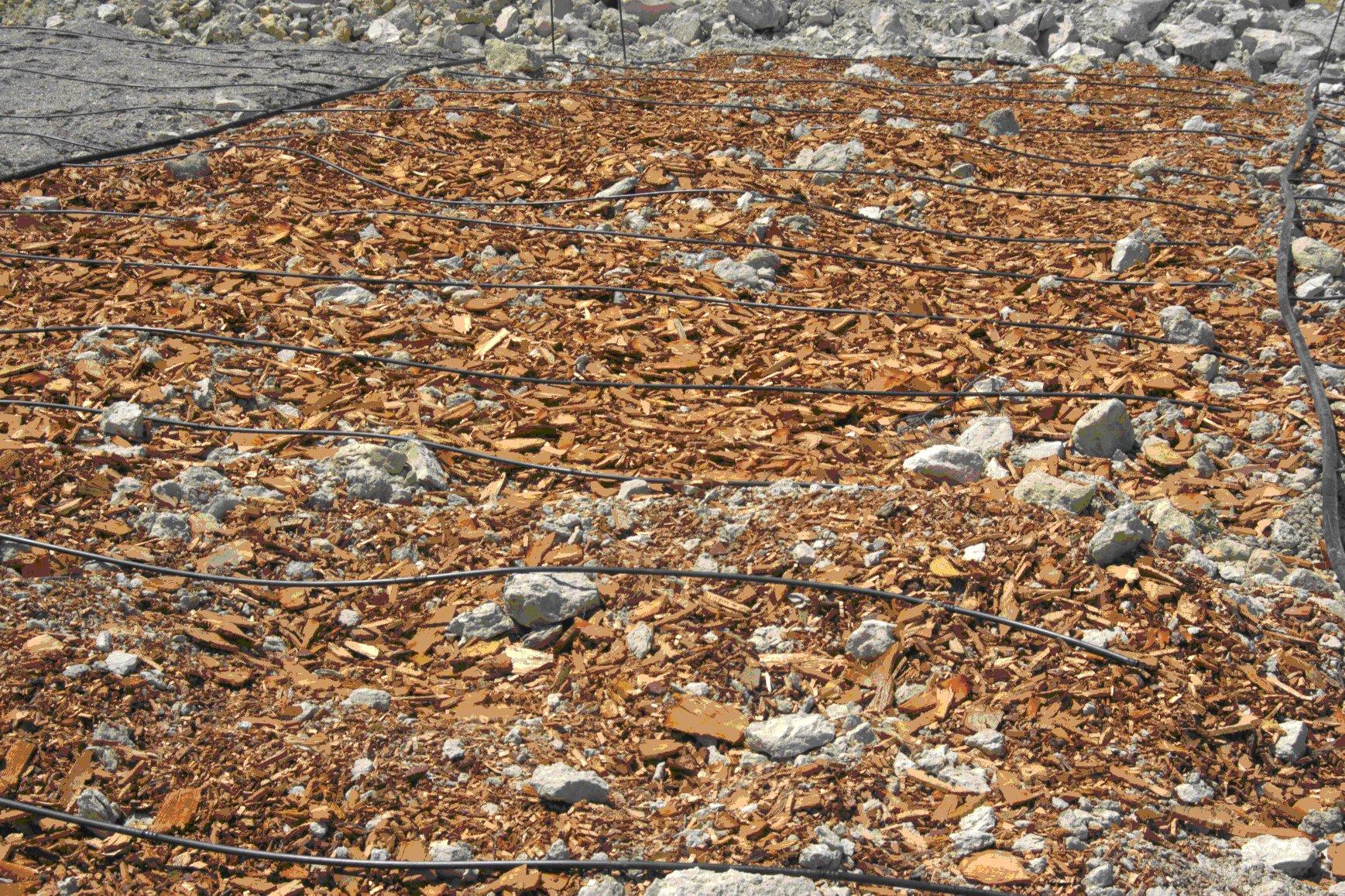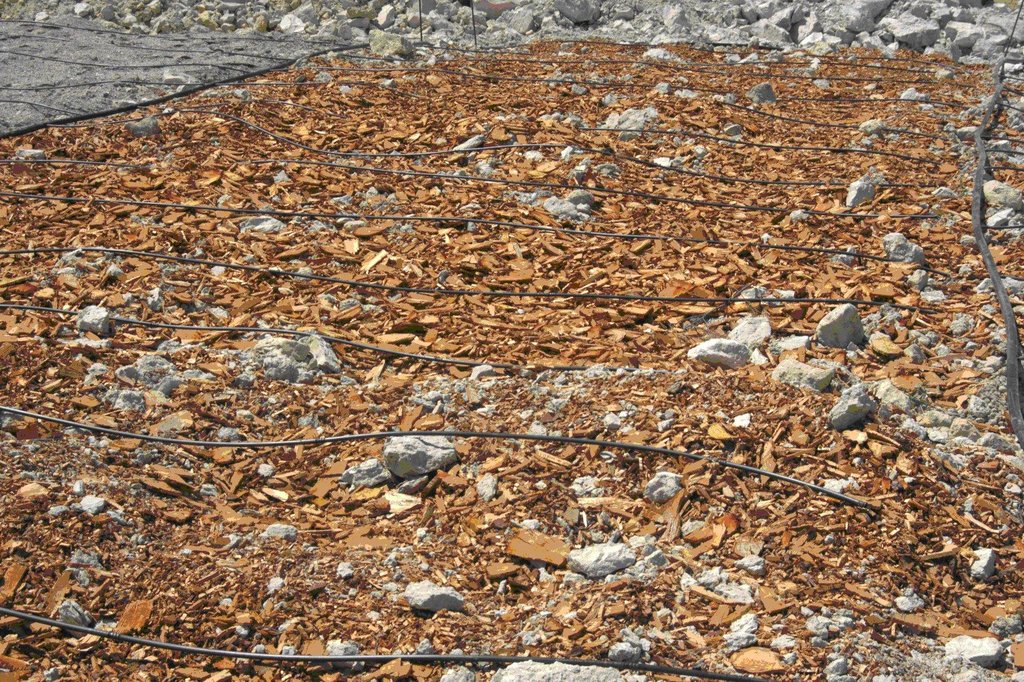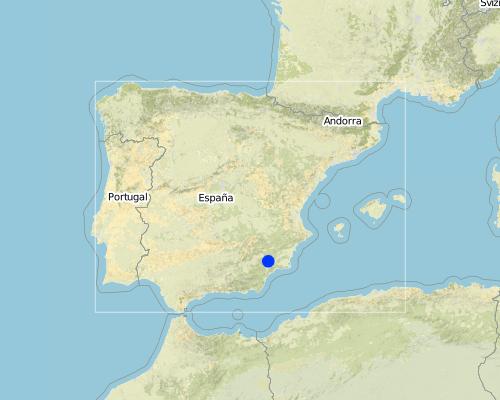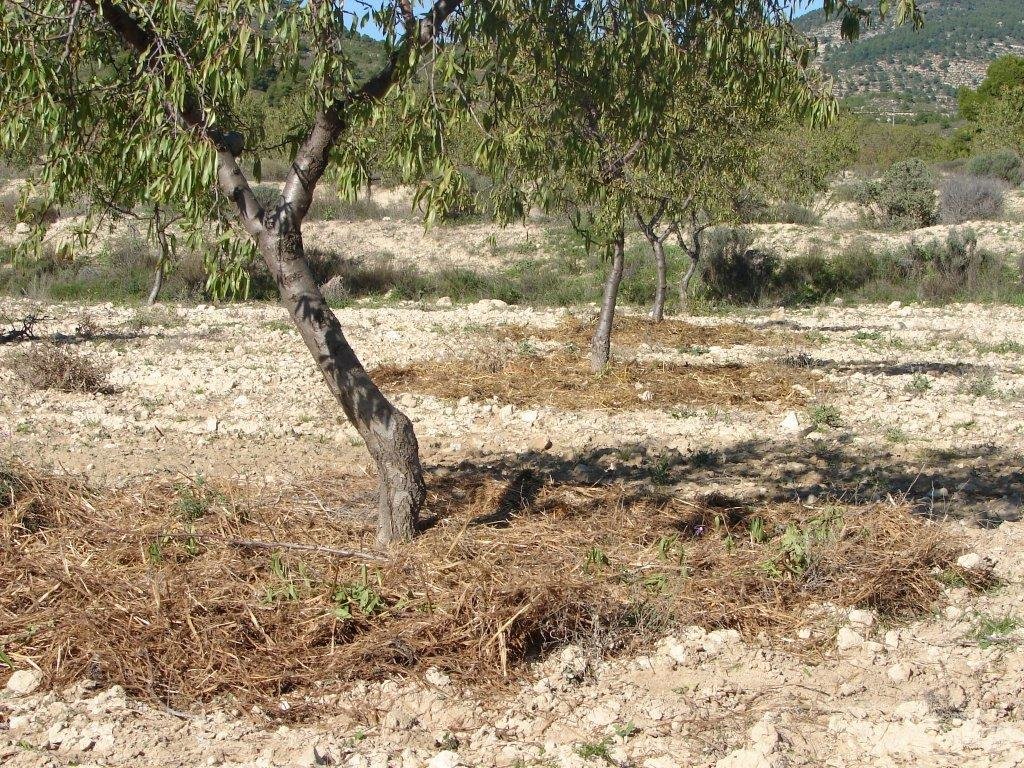Organic mulch under almond trees [西班牙]
- 创建:
- 更新:
- 编制者: Joris De Vente
- 编辑者: –
- 审查者: Alexandra Gavilano
Acolchados orgánicos en campos de almendro (ES)
technologies_1109 - 西班牙
查看章节
全部展开 全部收起1. 一般信息
1.2 参与该技术评估和文件编制的资源人员和机构的联系方式
关键资源人
SLM专业人员:
Ibáñez Torres Ascensión
34.968 36 66 87 / +34 699 65 36 16
ascension.ibanez@carm.es
Responsible technician of the rural development service (CARM). Consejería de Agricultura y Agua Murcia;
有助于对技术进行记录/评估的机构名称(如相关)
EEZA-CSIC (EEZA-CSIC) - 西班牙1.3 关于使用通过WOCAT记录的数据的条件
(现场)数据是什么时候汇编的?:
05/05/2011
编制者和关键资源人员接受有关使用通过WOCAT记录数据的条件。:
是
2. SLM技术的说明
2.1 技术简介
技术定义:
Organic mulching to protect against rain-splash, sheet wash and rill formation, reduce evaporation losses and weed growth.
2.2 技术的详细说明
说明:
Organic mulch is applied in Almond fields to provide a permanent surface cover that protects the soil against soil erosion, reduces evaporation and limits the growth of weeds. This makes that less ploughing is needed under Almond trees that are normally ploughed 3-5 times per year if no mulch cover is present. The material used for mulching can be diverse. Most feasible are straw or bark and wood chips from pruning residues from almonds and forest species (mostly pines). Alternatively, alpha-grass can be used as mulch. Mulch can best be applied late spring or early summer in order to maintain soil humidity of spring rainfall. Mulch should come mixed and homogenised. It is spread around trees by a mechanical spade or by the arm of a caterpillar. A layer of maximum 3-5 cm of mulch should be applied for economical reasons.
Purpose of the Technology: The ultimate goal of organic mulching under almond trees is to maintain soil water through a reduced evaporation and reduce soil loss by erosion. A mulch covers reduces soil erosion by 1) reducing raindrop impact, 2) increasing water infiltration, 3) increasing surface storage, 4) decreasing runoff velocity, 5) improving soil structure and porosity, and 6) improving the biological activity in the soil. Mulching prevents off-site effects of erosion like flooding, damage to infrastructure and siltation of water reservoirs, while maintaining or slightly increasing crop productivity. The mulch results in a higher soil roughness, a better infiltration of water into the soil, and so also in a reduced runoff. The mulch also has a favorable effect on soil quality since the organic material of the mulch will slowly decompose and provide nutrients to the soil. The decomposing part of the organic mulch will increase aggregation and soil structure through the production of organic compounds (e.g. humic acids). The reduced necessity for ploughing of the Almond fields will result in less fuel use and labour as well as reduced emission of CO2. In addition, the mulch cover prevents weeds to grow and so less competition from weeds will occur and less herbicides are needed.
Establishment / maintenance activities and inputs: The establishment of mulching depends on the material used for mulching. Given its availability, the easiest is the use of pruning residue from Almond trees. Almonds are pruned in autumn, and residue can be chopped and applied directly or stored in the field until early spring. Residues are chopped and spread around the tree stem and if enough material is available between tree stems. Alternatively, and depending on availability, pruning residue of pine trees or alpha-grass can be used. Pine tree residue should come from nearby forest stands and need to be chopped just like the almond pruning residue in spring. Litter from the forest floor should not be used as this will cause damage to the forest. Alpha-grass is very common in the region and should be harvested in winter in the fields surrounding the cultivated area without destroying the plant allowing it to regenerate. The alpha-grass does not need to be chopped and can be put around the tree stem of the almond trees.
Natural / human environment: The technology is feasible for soils of shallow to medium depth (between 20-60 cm), and with gentle to moderate slope gradients (2 - 8%). The climate is semi-arid with a mean annual rainfall around 300 mm. Droughts, centred in summer commonly last for more than 4-5 months. Annual potential evapotranspiration rates larger than 1000 mm are common. The production system is highly mechanised and market oriented but depends strongly on agricultural subsidies. All cropland is privately owned.
2.3 技术照片
2.5 已应用该技术的、本评估所涵盖的国家/地区/地点
国家:
西班牙
区域/州/省:
Murcia
有关地点的进一步说明:
Guadalentin catchment
Map
×2.6 实施日期
如果不知道确切的年份,请说明大概的日期:
- 10-50年前
2.7 技术介绍
详细说明该技术是如何引入的:
- 在实验/研究期间
注释(项目类型等):
Mulching is a well-known technique. However, until now not widely applied under semi-arid conditions without irrigation. With irrigation, plastic mulch is widely applied.
3. SLM技术的分类
3.2 应用该技术的当前土地利用类型

混合(作物/放牧/树木),包括农林
注释:
Major land use problems (compiler’s opinion): A lack of water availability seriously limits the production potential of the soil and results in a low vegetation/crop cover. The relatively high soil erosion rates cause various off-site related problems (i.e. flooding, reservoir siltation) and on-site problems (i.e. gully formation and loss of soil depth).
Major land use problems (land users’ perception): Lack of water for irrigation of crops limiting the crop types that can be planted as well as the crop yield of dryland farming.
Livestock is grazing on crop residues
3.3 有关土地利用的更多信息
其它(比如洪水后):
- all three
注释:
Water supply: rainfed, mixed rainfed - irrigated
每年的生长季节数:
- 1
具体说明:
Longest growing period in days: 220Longest growing period from month to month: November to June
3.5 技术传播
具体说明该技术的分布:
- 均匀地分布在一个区域
如果该技术均匀地分布在一个区域上,请注明覆盖的大致区域。:
- < 0.1 平方千米(10 公顷)
注释:
No examples are known of organic mulching that are applied in the area.
3.6 包含该技术的可持续土地管理措施

农艺措施
- A1:植被和土壤覆盖层
注释:
Main measures: agronomic measures
Type of agronomic measures: mulching
3.7 该技术强调的主要土地退化类型

土壤水蚀
- Wt:表土流失/地表侵蚀
- Wo:场外劣化效应

物理性土壤退化
- Pk:熟化和结壳

水质恶化
- Ha:干旱化
注释:
Main type of degradation addressed: Wt: loss of topsoil / surface erosion, Pk: sealing and crusting, Ha: aridification
Secondary types of degradation addressed: Wo: offsite degradation effects
Main causes of degradation: crop management (annual, perennial, tree/shrub) (Almond fields often have a very low surface cover by vegetation during long periods of the year, due to frequent ploughing, leaving the soil unprotected against raindrop impact and rill or gully forma), disturbance of water cycle (infiltration / runoff) (Reduced infiltration capacity causing runoff and soil erosion), poverty / wealth (Alternative and more profitable labour sources are a permanent risk of land abandonment that can lead to degradation.)
Secondary causes of degradation: Heavy / extreme rainfall (intensity/amounts) (High intensity erosive rainfall is common), droughts (Dry periods and dry years require higher water availability)
3.8 防止、减少或恢复土地退化
具体数量名该技术与土地退化有关的目标:
- 防止土地退化
- 减少土地退化
注释:
Main goals: prevention of land degradation, mitigation / reduction of land degradation
4. 技术规范、实施活动、投入和成本
4.1 该技术的技术图纸
4.2 技术规范/技术图纸说明
Photo of how the mulch should be divided under the tree stems. If enough material is available, a continuous cover without bare surfaces between trees is recommended.
Technical knowledge required for field staff / advisors: moderate (Knowledge on the type of material used for mulch is essential)
Technical knowledge required for land users: low (The application in the field is simple)
Main technical functions: control of raindrop splash, control of dispersed runoff: retain / trap, control of dispersed runoff: impede / retard, control of concentrated runoff: retain / trap, control of concentrated runoff: impede / retard, improvement of ground cover, increase / maintain water stored in soil
Secondary technical functions: increase of surface roughness, improvement of surface structure (crusting, sealing), increase in organic matter
Mulching
Material/ species: organic material (almond pruning, pine chips, alpha-grass)
Quantity/ density: max 3-5 cm
4.4 技术建立活动
| 活动 | 措施类型 | 时间 | |
|---|---|---|---|
| 1. | animal traction | 管理 |
4.5 技术建立所需要的费用和投入
| 对投入进行具体说明 | 单位 | 数量 | 单位成本 | 每项投入的总成本 | 土地使用者承担的成本% | |
|---|---|---|---|---|---|---|
| 设备 | animal traction | hectare | 1.0 | 238.0 | 238.0 | 100.0 |
| 技术建立所需总成本 | 238.0 | |||||
注释:
Duration of establishment phase: 12 month(s)
4.6 维护/经常性活动
| 活动 | 措施类型 | 时间/频率 | |
|---|---|---|---|
| 1. | Cut alpha-grass (optional) | 农业学的 | winter |
| 2. | apply mulch of alpha-grass, almond and pine tree pruning residue | 农业学的 | early spring or autumn after almond pruning |
4.7 维护/经常性活动所需要的费用和投入(每年)
| 对投入进行具体说明 | 单位 | 数量 | 单位成本 | 每项投入的总成本 | 土地使用者承担的成本% | |
|---|---|---|---|---|---|---|
| 劳动力 | labour emdium | hectare | 1.0 | 421.0 | 421.0 | 100.0 |
| 设备 | machine use | hectare | 1.0 | 44.0 | 44.0 | 100.0 |
| 植物材料 | mulch of chopped pine trees | hectare | 1.0 | 650.0 | 650.0 | 100.0 |
| 技术维护所需总成本 | 1115.0 | |||||
注释:
Machinery/ tools: Tractor and chopper to chop the almond pruning residue.
The original price of the chopper is estimated at $4761. In calculations it is assumed that the chopper is shared between at least two farmers, and with an average farm size of 10 ha, which gives a price of $238/ha establishment costs. Calculations include the cutting of alpha-grass to apply this as mulch in addition to the chopped almond and pine tree residue. Excluding the alpha-grass as a mulch reduces the total maintenance cost to 650. Leaving out also the chopped pine tree residue and using only the chopped almond pruning residue reduces maintenance costs to $44. The costs were indicated assuming a distance of 7 meter between almond trees and a mulch cover around each tree of 3*3 meters. Prices are for spring 2008.
4.8 影响成本的最重要因素
描述影响成本的最决定性因素:
Labour for cutting alpha grass, and the price of the mulch are most determining factors of the costs. Almond prunings are free of charge (except for costs to chop them), but will not provide enough mulch. Chopped Pine pruning or straw mulch are relatively expensive.
5. 自然和人文环境
5.1 气候
年降雨量
- < 250毫米
- 251-500毫米
- 501-750毫米
- 751-1,000毫米
- 1,001-1,500毫米
- 1,501-2,000毫米
- 2,001-3,000毫米
- 3,001-4,000毫米
- > 4,000毫米
农业气候带
- 半干旱
Thermal climate class: subtropics
Thermal climate class: temperate. The higher parts are generally somewhat colder
5.2 地形
平均坡度:
- 水平(0-2%)
- 缓降(3-5%)
- 平缓(6-10%)
- 滚坡(11-15%)
- 崎岖(16-30%)
- 陡峭(31-60%)
- 非常陡峭(>60%)
地形:
- 高原/平原
- 山脊
- 山坡
- 山地斜坡
- 麓坡
- 谷底
垂直分布带:
- 0-100 m a.s.l.
- 101-500 m a.s.l.
- 501-1,000 m a.s.l.
- 1,001-1,500 m a.s.l.
- 1,501-2,000 m a.s.l.
- 2,001-2,500 m a.s.l.
- 2,501-3,000 m a.s.l.
- 3,001-4,000 m a.s.l.
- > 4,000 m a.s.l.
5.3 土壤
平均土层深度:
- 非常浅(0-20厘米)
- 浅(21-50厘米)
- 中等深度(51-80厘米)
- 深(81-120厘米)
- 非常深(> 120厘米)
土壤质地(表土):
- 中粒(壤土、粉土)
- 细粒/重质(粘土)
表土有机质:
- 中(1-3%)
- 低(<1%)
5.4 水资源可用性和质量
地下水位表:
5-50米
地表水的可用性:
匮乏/没有
水质(未处理):
仅供农业使用(灌溉)
5.5 生物多样性
物种多样性:
- 低
5.6 应用该技术的土地使用者的特征
生产系统的市场定位:
- 混合(生计/商业
- 商业/市场
非农收入:
- > 收入的50%
相对财富水平:
- 平均水平
个人或集体:
- 个人/家庭
机械化水平:
- 机械化/电动
性别:
- 男人
说明土地使用者的其他有关特征:
Land users applying the Technology are mainly common / average land users
Difference in the involvement of women and men: Traditionally most agriculture is done by men in this region.
Population density: 10-50 persons/km2
Annual population growth: < 0.5%
15% of the land users are rich and own 20% of the land.
80% of the land users are average wealthy and own 75% of the land.
5% of the land users are poor and own 5% of the land.
Off-farm income specification: There is no difference in the ones who apply the technology and those who don’t. Most farmers do have an off-farm income for example from hunting, work in a factory, or office.
5.7 应用该技术的土地使用者拥有或租用的平均土地面积
- < 0.5 公顷
- 0.5-1 公顷
- 1-2 公顷
- 2-5公顷
- 5-15公顷
- 15-50公顷
- 50-100公顷
- 100-500公顷
- 500-1,000公顷
- 1,000-10,000公顷
- > 10,000公顷
这被认为是小规模、中规模还是大规模的(参照当地实际情况)?:
- 小规模的
注释:
Average area of land owned or leased by land users applying the Technology: 15-50 ha, 50-100 ha, 100-500 ha
5.8 土地所有权、土地使用权和水使用权
土地所有权:
- 州
- 个人,有命名
土地使用权:
- 社区(有组织)
- 个人
用水权:
- 社区(有组织)
- 个人
注释:
Most land is privately owned. Some shrubland or forest is state property. Water use is organised by permits to water extraction from aquifers on individual basis. Water rights are provided and controlled by the Water authority of the Segura river basin (CHS).
5.9 进入服务和基础设施的通道
健康:
- 贫瘠
- 适度的
- 好
教育:
- 贫瘠
- 适度的
- 好
技术援助:
- 贫瘠
- 适度的
- 好
就业(例如非农):
- 贫瘠
- 适度的
- 好
市场:
- 贫瘠
- 适度的
- 好
能源:
- 贫瘠
- 适度的
- 好
道路和交通:
- 贫瘠
- 适度的
- 好
饮用水和卫生设施:
- 贫瘠
- 适度的
- 好
金融服务:
- 贫瘠
- 适度的
- 好
6. 影响和结论性说明
6.1 该技术的现场影响
社会经济效应
生产
作物生产
水资源可用性和质量
灌溉用水需求
收入和成本
农业投入费用
农业收入
社会文化影响
SLM/土地退化知识
冲突缓解
生态影响
水循环/径流
水质
地表径流
多余水的排放
蒸发
土壤
土壤水分
土壤覆盖层
土壤流失
土壤结壳/密封
土壤有机物/地下C
生物多样性:植被、动物
动物多样性
有益物种
减少气候和灾害风险
碳和温室气体的排放
6.2 该技术的场外影响已经显现
下游洪水
下游淤积
地下水/河流污染
缓冲/过滤能力
风力搬运沉积物
对邻近农田的破坏
对公共/私人基础设施的破坏
6.3 技术对渐变气候以及与气候相关的极端情况/灾害的暴露和敏感性(土地使用者认为的极端情况/灾害)
渐变气候
渐变气候
| 季节 | 气候变化/极端天气的类型 | 该技术是如何应对的? | |
|---|---|---|---|
| 年温度 | 增加 | 好 |
气候有关的极端情况(灾害)
气象灾害
| 该技术是如何应对的? | |
|---|---|
| 局地暴雨 | 好 |
| 局地风暴 | 好 |
气候灾害
| 该技术是如何应对的? | |
|---|---|
| 干旱 | 好 |
水文灾害
| 该技术是如何应对的? | |
|---|---|
| 比较和缓的(河道)洪水 | 不好 |
其他气候相关的后果
其他气候相关的后果
| 该技术是如何应对的? | |
|---|---|
| 缩短生长期 | 好 |
6.4 成本效益分析
技术收益与技术建立成本相比如何(从土地使用者的角度看)?
短期回报:
消极
长期回报:
稍微积极
技术收益与技术维护成本/经常性成本相比如何(从土地使用者的角度看)?
短期回报:
轻度消极
长期回报:
稍微积极
注释:
Mulch is relatively expensive and so implies an additional cost.
6.5 技术采用
注释:
There is no trend towards spontaneous adoption of the Technology
Comments on adoption trend: There is not so much awareness, and most farmers are afraid of possible costs of mulching and don’t count on increased crop yield.
6.7 该技术的优点/长处/机会
| 土地使用者眼中的长处/优势/机会 |
|---|
|
A good surface cover throughout the year provides good protection against erosion and helps reducing number of tillage operations and expenses How can they be sustained / enhanced? no suggestions |
| 编制者或其他关键资源人员认为的长处/优势/机会 |
|---|
|
The main advantage is that a good surface cover is obtained below almonds that traditionally are characterised by a very poor surface cover during the whole year. The mulch will reduce evaporation and prevent erosion to take place. How can they be sustained / enhanced? Cheapest type of mulch should be identified (alpha grass, chopped pruning residues, …). |
6.8 技术的弱点/缺点/风险及其克服方法
| 土地使用者认为的弱点/缺点/风险 | 如何克服它们? |
|---|---|
| The price of the mulch | Look for alternative low cost materials |
| 编制者或其他关键资源人员认为的弱点/缺点/风险 | 如何克服它们? |
|---|---|
| The price of the mulch and/or the price of carrying it to the field | Look for alternative low cost materials, the nearest to the plots as possible. |
| Once the mulch in situ, any tillage operation would incorporate it to the soil, reducing part of its initial benefit; if the mulch is green (alpha grass) it would depress soil N levels upon decomposition, though it would increase SOM in the medium-long term | Avoid tillage in mulched areas |
7. 参考和链接
7.2 参考可用出版物
标题、作者、年份、ISBN:
Smets, T., Poesen, J. and Knapen, A., 2008. Spatial scale effects on the effectiveness of organic mulches in reducing soil erosion by water. Earth-Science Reviews, 89(1-2): 1-12.
可以从哪里获得?成本如何?
Internet
标题、作者、年份、ISBN:
Verdu and Mas 2007. Mulching as an alternative technique for weed management in mandarin orchard tree rows. AGRONOMY FOR SUSTAINABLE DEVELOPMENT. 27(4): 367-375
可以从哪里获得?成本如何?
Internet
标题、作者、年份、ISBN:
http://www.isahispana.com/
可以从哪里获得?成本如何?
Internet
标题、作者、年份、ISBN:
Mellouli, H.J., van Wesemael, B., Poesen, J. and Hartmann, R., 2000. Evaporation losses from bare soils as influenced by cultivation techniques in semi-arid regions. Agricultural Water Management, 42(3): 355-369.
可以从哪里获得?成本如何?
Internet
链接和模块
全部展开 全部收起链接
无链接
模块
无模块





